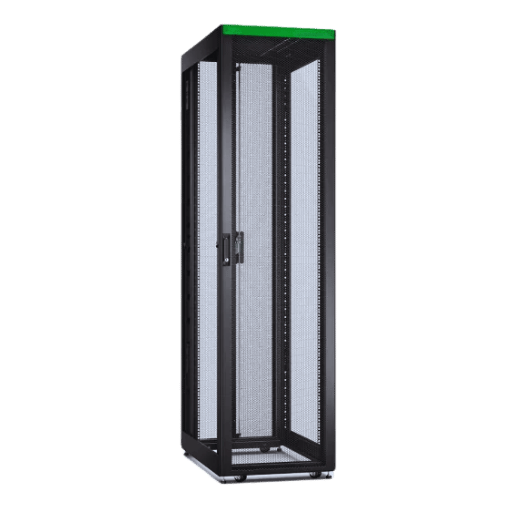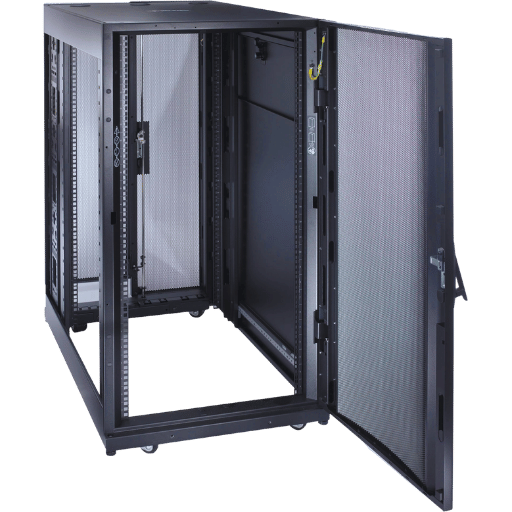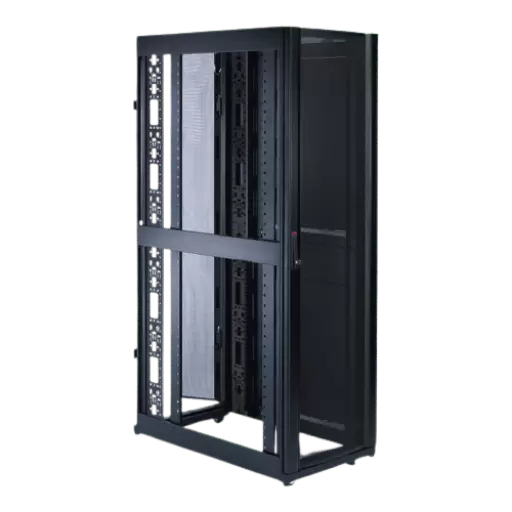Regarding critical IT equipment for housing, safety, efficiency, and scalability are of utmost importance. APC server racks are customized to fulfill the requirements of contemporary enterprises through an adaptable approach that integrates advanced concepts and practical solutions. These enclosures offer the durability, organization, and flexibility required for optimizing your infrastructure, whether running a small server room or a large-scale data center. This article discusses the distinct characteristics and advantages of APC server rack enclosures and why IT experts across the globe have them as their preferred option. From advanced cable management to powerful security options, see how APC enclosures improve the dependability and performance of your IT environment.

APC’s racks mount servers with modern IT environments in mind. APC server racks have the following features:
APC racks make organizing and scaling an IT infrastructure secure and more manageable, making them a dependable solution for most businesses.
APC’s Netshelter SX Series features high-performance IT enclosures to support critical IT infrastructure at data centers, server rooms, and network closets. IT enclosures elevate operational efficiency through airflow optimization, adequate equipment storage, and cable management. The Netshelter SX’s modular design allows diverse hardware configurations to be flexibly integrated to accommodate prospective expansion. Its durable, rugged construction complements modern IT environments, including data centers and server rooms. Advanced tool-less mounting features and adjustable permanent rails further enhance adaptability.
The adjustable side panels and roof panels of IT enclosures improve access and airflow, especially in half-height configurations. These features enable easy access to internal parts, making maintenance and hardware changes uncomplicated. Furthermore, these features allow customizable airflow pathways to improve cooling and avoid overheating. This adaptability ensures equipment setup compatibility, thus supporting reliable operations within demanding IT environments.
APC racks improve cooling and airflow control with adjustable mounting rails and doors that maximize ventilation. These vents enhance air circulation while also preventing the formation of hotspots, ensuring that the working temperatures remain optimal. APC racks also accept unobstructed airflow cable management systems that enhance cooling efficiency. These features safeguard thermal conditions, improving equipment performance reliability across diverse IT infrastructure environments.

Considering equipment such as servers and associated networking components, calculate their physical dimensions relative to the height and depth of the rack. When determining the depth of the rack, consider placing the equipment and the cables needed for the device, taking care to maintain enough distance for ventilation and proper airflow along with untangled cables. For height, estimate the total number of rack units (U) by adding the size of all devices while ensuring room for future growth. Depths are usually between 24 and 48 inches, while height is typically between 42U and 48U. However, these measurements should be based case by case on predicted device requirements. Choosing the size best suits current needs enhances optimizing available space, ensuring device effectiveness and intended purposes.
Effective cable management within a server environment maximizes operational productivity while maintaining system dependability. The overhead space should also be considered when optimizing a server’s airflow. Hardware performance can be improved with organized cables and mitigated risk of overheating, especially in overhead cable management systems. Maintenance and upgrades are standard in a server; thus, having structured cables alongside clear labeling enhances productivity by reducing errors and streamlining troubleshooting time. Apart from the productivity boost, effective cable management helps minimize trip hazards that cause physical damage to the cables, increasing the cable’s lifespan and ensuring disruption-free connectivity. Proper organization significantly impacts a server’s efficiency, professional appearance, and overall functionality.
Distributing power efficiently and reliably within a data center environment is critical, especially when managing high-density loads in half-height racks. PDUs are crucial since they link a power source and devices by distributing electrical power to various tasks. Basic PDUs, metered PDUs, surveyed PDUs, and switched PDUs are PDUs, each with its level of sophistication.
Basic PDUs are the simplest and provide power with no control or monitoring capabilities, which suits small-scale functions. For advanced applications, metered PDUs offer monitoring at the unit level, which is essential for energy management. Monitored PDUs allow controlling data centers by curbing blowing and optimizing power usage through real-time reporting and alerting functions.
Switched PDUs take advanced control a notch higher for remote management by enabling operators to manage power on individual sockets. This is helpful when rebooting servers or managing power in large-scale environments. Eco-friendly PDUs also allow monitoring of temperature and humidity levels to sustain ideal working conditions.
Numerous facilities now use three-phase power systems instead of single-phase ones to optimize power distribution and load balancing in accommodating high-density loads. Three-phase PDUs increase load balancing and reduce the required circuits, thereby increasing infrastructure simplicity.
Facilities that focus on having energy-optimized systems powered with intelligent analytics rely on having minimal operational costs and improved overall sustainability. Such cases include the installation of smart PDUs that can enforce optimized power usage patterns, ensuring devices are within predetermined limits while minimizing energy waste, supporting green initiatives, and aiding in fulfilling contractual obligations.
In the end, the right choice of power distribution option depends on the power requirements of the hardware, the scale of the environment, and the organization’s governing policies.

The APC NetShelter SX 42U rack enclosure is structured to house various components of IT equipment while optimizing the space concerning cooling and cable management. It has a sturdy and flexible frame for standard servers and networking peripherals. These include, among others, simple installation without the need for tools, vertical mounting for adjustable depth, and automatic cable organization. Moreover, its perforated front and rear doors improve airflow and assist in thermal management. This enclosure is ideal for data centers, server rooms, and enterprise-class environments with diverse needs and dependable systems for storing rack-mount devices.
Modular and toolless installation simplifies the initial configuration of networking hardware by minimizing the time and effort required. Tool-free mounting options enable simple changes and reconfigurations of hardware, supporting diverse equipment requirements without special tools. This flexibility lowers downtime and boosts operational efficiency while meeting infrastructure shifts, which is excellent for contemporary IT settings that require fast-paced changes.
The customization of hardware and other accessories enables precise solutions to cater to specific equipment and organizational requirements. Adjustable brackets, trays that help manage cables, and modular mounting systems provide specific configurations for maximum spatial efficiency. These strategies aid in adaptability and can be easily incorporated into current frameworks, streamlining processes while increasing efficiency.

When installing brackets and equipment using a panel mount, choose compatible brackets and mounts based on character devices and your rack configuration. The manufacturer’s instructions should be followed when the brackets are attached to the equipment, which, as previously mentioned, requires all screws to be fastened. The equipment should now be aligned to the corresponding rack. It will be held in place with panel mounts, ensuring it remains bonded and aligned with the rack. In the end, confirm all junctions, connections, and screws were tightly secured and properly aligned in a way that avoids buttress scroll movement or any form of imbalance while in operation.
Preserving ideal airflow must be completed to prevent overheating and guarantee the proper function of all rack-mounted equipment. To accomplish optimal airflow, sustain control of the layout of all your devices and refrain from obstructing pathways or vents. Control airflow by managing blanked-off spaces in racks so air is channeled through functioning parts rather than leaking through passive slots. Also, ensure that hot and cold aisle arrangements are applied, which means arranging the equipment so that the exhaust airflow from one row does not mix with the intake of the succeeding equipment.
Maintaining a crucial role in providing accurate and required conditions for the ease of operation of devices so that the rating of the equipment is not exceeded and damaged. The standards dictate that the temperature range be set above 64.4 °F (18 °C) and below 80.6 °F (27 °C), with the moisture relative humidity set at 40 up to 60 percent to minimize the chance of static electricity discharge and exclusion. Innovative systems with monitoring capabilities can measure temperature, humidity, and airflow in real-time alongside monitoring clocks that signal deviation from pre-set limits in the system. This will help frontline technicians in providing measures beforehand. With these implementations, the interference of some environmental constraints that can plug into the equipment is minimized, thus increasing their life span and functions.

Routine cable checks and hardware inspections within a server rack proactively help prevent future complications and guarantee optimal performance. Starting from the top, look for fraying or bending at connection points, and ensure that all damaged cables are replaced immediately. Ensure that all wires are connected to their ports, Bundled, organized, and aligned so as not to restrict airflow. Check that all hardware comprising brackets, railings, and fasteners are where they should be and are not compromised. All screws and mounts need to be verified for proper tightening. Make a habit of verifying the functionality of critical hardware – power supplies and network switches – and fix areas that seem problematic early on. Record all details in a provided log so that providing access to recorded issues, documented inspections, and maintenance schedules becomes easy.
Properly managing air distribution and cooling systems maintains the optimal operating temperatures of data centers and similar environments. To foster unrestricted airflow and heat dissipation, improve vent obstruction avoidance, and lay equipment logically. Minimize the impact of inefficiencies by maintaining air filters, checking for cooling unit wear, and confirming the system’s performance. Where possible, augment cooling and reduce energy use through the hot aisle/cold aisle configuration. Use dependable temperature sensors for monitoring and make prompt adjustments to prevent overheating or energy waste.
Maintaining optimal and secure operational conditions in any facility requires environmental and security monitoring, especially in places featuring power distribution systems. Implement environmental monitoring measures that help track temperature, humidity, and airflow. Data collection and analysis should be done accurately using calibrated sensors and centralized management systems. Automate and set up alerts to predefined thresholds to guarantee proper response to noted deviations.
CCTV and other surveillance systems must be installed to monitor critical areas, and round-the-clock monitoring should be provided. Empirical security measures such as access control gates should be used with electronic surveillance to prevent unauthorized entry into those areas. Regular audits for monitoring systems can pose issues concerning gaps in security control about specific security conditions. Look out for consistent testing and updating of systems to ensure operability.
A: APC server rack enclosures include various server technologies, such as vertical mounting rails, enhanced cooling systems, and the ability to support other network devices. Some popular units are the NetShelter WX and floor-standing types, which include 600w x 1070d mm specifications. These enclosures serve well for medium data center density setups.
A: APC cabinets were constructed to support high-density setups with advanced cooling, zero U space for PDPs, and several other hardware cable management features, such as vertical cable organizers. These computer systems are designed to ensure unobstructed airflow and easy serviceability of all equipment.
A: With APC server rack solutions, users enjoy improved control over the arrangement of server and networking devices, optimal ventilation accomplished via front perforated doors for easy heat release, and enhanced security featuring lockable doors or grounding inserts. They also offer wall-mount and floor-standing units, so users save on floor space.
A: These enclosures improve data center productivity with features such as split rear door access, shock packaging, and supporting compute and networking class equipment. The ease of access afforded by split rear doors, secure transport shock packaging, and support for heavy-duty computing and networking class equipment enhances data center productivity. APC racks are also designed to support light and heavy devices seamlessly. APC racks seamlessly support devices of varying weight classes.
A: The installation manual for APC server racks includes information on wiring, grounding inserts, vertical cable management, and other necessary installation components. Each server rack has a small footprint, comes in multiple sizes, including 6U, and is designed to efficiently house computing and network infrastructure.
A: Indeed, APC enclosures can support both server and networking equipment. They have been designed to accept a variety of equipment, including small LANs and extensive networks, and each enclosure has built-in C13 outlets for effective power distribution.
A: APC provides several cooling options, including split rear doors and perforated front doors. They use rack-mount PDUs and blanking panels to manage airflow pathways for cross-flow ventilation, ensuring networking devices operate within their temperature thresholds.
A: Indeed, APC racks are customizable with castors or wheels. This allows for effortless adjustment and repositioning of the racks within the data center, allowing for flexible implementation of server rack architectures within the data center.
A: APC server racks comprise protective components and shut violence sheltering features alongside lockable front doors, which protect physical equipment and data theft. These features help protect data center resources against illegal access and assist in performing damage monitoring and controlling mechanisms.
1. Title: APC Back-UPS RS LCD (1500 VA); Chloride Desk Power Plus Rack (1400 VA): proactive protection of equipment
2. Title: APC : Smart-UPS RT 15 et 20 KVA, des onduleurs 12U innovants pour Datacentres et salles serveurs
3. Title: A Case For Intra-rack Resource Disaggregation in HPC